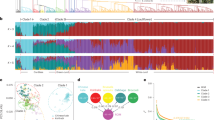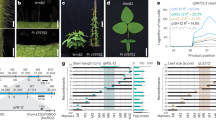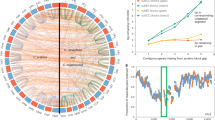Abstract
Grain-filling, an important trait that contributes greatly to grain weight, is regulated by quantitative trait loci and is associated with crop domestication syndrome1,2,3,4. However, the genes and underlying molecular mechanisms controlling crop grain-filling remain elusive. Here we report the isolation and functional analysis of the rice GIF1 (GRAIN INCOMPLETE FILLING 1) gene that encodes a cell-wall invertase required for carbon partitioning during early grain-filling. The cultivated GIF1 gene shows a restricted expression pattern during grain-filling compared to the wild rice allele, probably a result of accumulated mutations in the gene's regulatory sequence through domestication. Fine mapping with introgression lines revealed that the wild rice GIF1 is responsible for grain weight reduction. Ectopic expression of the cultivated GIF1 gene with the 35S or rice Waxy promoter resulted in smaller grains, whereas overexpression of GIF1 driven by its native promoter increased grain production. These findings, together with the domestication signature that we identified by comparing nucleotide diversity of the GIF1 loci between cultivated and wild rice, strongly suggest that GIF1 is a potential domestication gene and that such a domestication-selected gene can be used for further crop improvement.
This is a preview of subscription content, access via your institution
Access options
Subscribe to this journal
Receive 12 print issues and online access
$209.00 per year
only $17.42 per issue
Buy this article
- Purchase on Springer Link
- Instant access to full article PDF
Prices may be subject to local taxes which are calculated during checkout




Similar content being viewed by others
Accession codes
Accessions
Gene Expression Omnibus
NCBI Reference Sequence
References
Takai, T., Fukuta, Y., Shiraiwa, T. & Horie, T. Time-related mapping of quantitative trait loci controlling grain-filling in rice (Oryza sativa L.). J. Exp. Bot. 56, 2107–2118 (2005).
Doebley, J.F., Gaut, B.S. & Smith, B.D. The molecular genetics of crop domestication. Cell 127, 1309–1321 (2006).
Yano, M. Genetic and molecular dissection of naturally occurring variation. Curr. Opin. Plant Biol. 4, 130–135 (2001).
Sweeney, M. & McCouch, S. The complex history of the domestication of rice. Ann. Bot. (Lond.) 100, 951–957 (2007).
International Rice Genome Sequencing Project. The map based sequence of the rice genome. Nature 436, 793–800 (2005).
Xue, W. et al. Natural variation in Ghd7 is an important regulator of heading date and yield potential in rice. Nat. Genet. 40, 761–767 (2008).
Fan, C. et al. GS3, a major QTL for grain length and weight and minor QTL for grain width and thickness in rice, encodes a putative transmembrane protein. Theor. Appl. Genet. 112, 1164–1171 (2006).
Li, J., Thomson, M. & McCouch, S.R. Fine mapping of a grain-weight quantitative trait locus in the pericentromeric region of rice chromosome 3. Genetics 168, 2187–2195 (2004).
Song, X.J., Huang, W., Shi, M., Zhu, M.Z. & Lin, H.X.A. QTL for rice grain width and weight encodes a previously unknown RING-type E3 ubiquitin ligase. Nat. Genet. 39, 623–630 (2007).
Ashikari, M. et al. Cytokinin oxidase regulates rice grain production. Science 309, 741–745 (2005).
Nagata, K., Yoshinaga, S., Takanashi, J. & Terao, T. Effects of dry matter production, translocation of nonstructural carbohydrates and nitrogen application on grain-filling in rice cultivar Takanari, a cultivar bearing a large number of spikelets. Plant Prod. Sci. 4, 173–183 (2001).
Zhu, Y. et al. ELONGATED UPPERMOST INTERNODE encodes a cytochrome P450 monooxygenase that epoxidizes gibberellins in a novel deactivation reaction in rice. Plant Cell 18, 442–456 (2006).
Cheng, W.-H., Taliercio, E.W. & Chourey, P.S. The miniature1 seed locus of maize encodes a cell wall invertase required for normal development of endosperm and maternal cells in the pedicel. Plant Cell 8, 971–983 (1996).
Fridman, E., Carrari, F., Liu, Y.S., Fernie, A.R. & Zamir, D. Zooming in on a quantitative trait for tomato yield using interspecific introgressions. Science 305, 1786–1789 (2004).
Roitsch, T. & Gonzalez, M.C. Function and regulation of plant invertases: sweet sensations. Trends Plant Sci. 9, 606–613 (2004).
Cho, J.I. et al. Molecular cloning and expression analysis of the cell wall invertase gene family in rice (Oryza sativa L.). Plant Cell Rep. 24, 225–236 (2005).
Sturm, A. & Tang, G.Q. The sucrose-cleaving enzymes of plants are crucial for development, growth and carbon partitioning. Trends Plant Sci. 4, 401–407 (1999).
Krishnan, S. & Dayanandan, P. Structural and histochemical studies on grain-filling in the caryopsis of rice (Oryza sativa L.). J. Biosci. 28, 455–469 (2003).
Tang, G.Q., Luscher, M. & Sturm, A. Antisense repression of vacuolar and cell wall invertase in transgenic carrot alters early plant development and sucrose partitioning. Plant Cell 11, 177–189 (1999).
Konishi, S. et al. An SNP caused loss of seed shattering during rice domestication. Science 312, 1392–1396 (2006).
Li, C., Zhou, A. & Sang, T. Rice domestication by reducing shattering. Science 311, 1936–1939 (2006).
Sweeney, M.T., Thomson, M.J., Pfeil, B.E. & McCouch, S. Caught red-handed: Rc encodes a basic helix-loop-helix protein conditioning red pericarp in rice. Plant Cell 18, 283–294 (2006).
Olsen, K.M. et al. Selection under domestication: evidence for a sweep in the rice waxy genomic region. Genetics 173, 975–983 (2006).
Caicedo, A.L. et al. Genome-wide patterns of nucleotide polymorphism in domesticated rice. PLoS Genet. 3, 1745–1756 (2007).
Wang, R.L., Stec, A., Hey, J., Lukens, L. & Doebley, J. The limits of selection during maize domestication. Nature 398, 236–239 (1999).
Wang, H. et al. The origin of the naked grains of maize. Nature 436, 714–719 (2005).
Hao, W., Jin, J., Sun, S.Y., Zhu, M.Z. & Lin, H.X. Construction of chromosome segment substitution lines carrying overlapping chromosome segments of the whole wild rice genome and identification of quantitative trait loci for rice quality. Zhi Wu Sheng Li Yu Fen Zi Sheng Wu Xue Xue Bao 32, 354–362 (2006).
Whitt, S.R., Wilson, L.M., Tenaillon, M.I., Gaut, B.S. & Buckler, E.S. Genetic diversity and selection in the maize starch pathway. Proc. Natl. Acad. Sci. USA 99, 12959–12962 (2002).
Kang, H.G., Park, S., Matsuoka, M. & An, G. White-core endosperm floury endosperm-4 in rice is generated by knockout mutations in the C-type pyruvate orthophosphate dikinase gene (OsPPDKB). Plant J. 42, 901–911 (2005).
Clark, R.M., Wagler, T.N., Quijada, P. & Doebley, J. A distant upstream enhancer at the maize domestication gene, tb1, has pleiotropic effects on plant and inflorescent architecture. Nat. Genet. 38, 594–597 (2006).
Acknowledgements
We thank J.Y. Li, T. Sang and J.M. Li for critical reading of the manuscript and helpful suggestions; B. Han for the rice BAC clone; Z.Y. Wang for the Waxy promoter; D. Luo for help with in situ hybridization; X.Y. Gao and X.S. Gao for assistance with scanning electron microscopy and confocal laser microscopy; X.M. Zhang, L.J. Zeng and S.H. Ye for rice growth; and H.Q. Zheng for assistance with sugar measurement. This work was supported by grants from the Ministry of Science and Technology of China (2007AA02Z162, 2006AA10A102 and 2007AA10Z187), grants from the National Natural Science Foundation of China (30721061 and 30623006) and the Reproductive Development Project of the Shanghai Institutes for Biological Sciences.
Author information
Authors and Affiliations
Contributions
E.W. and Z.H. conceived the research project, designed experiments and analyzed the data. E.W. carried out field phenotyping, genetics, gene cloning and functional and molecular evolution experiments. X.Z. screened the mutant. J.W. and L.W. conducted the genetic and field phenotype analyses. W. Hao, H.L. and G.Z. developed the introgression lines. Q.L. helped with the microarray assay. L.Z. helped with field testing. W. He helped with in situ hybridization. H.M. contributed to the funding and discussed the experiments. B.L. helped with wild rice analysis. Z.H. oversaw the entire study.
Corresponding author
Supplementary information
Supplementary Text and Figures
Supplementary Methods, Supplementary Figures 1–12, Supplementary Tables 1, 4 and 6 (PDF 999 kb)
Supplementary Table 2 (Excel)
Summary of 341 reproducibly differentially regulated genes of the gif1 mutant versus wild-type Zhonghua11 at 7 DAF (XLS 185 kb)
Supplementary Table 3 (Excel)
Summary of 44 carbohydrate metabolism-related genes reproducibly differentially regulated in the gif1 mutant versus wild-type Zhonghua11 at 7 DAF (XLS 61 kb)
Supplementary Table 5 (Excel)
Analysis of recombinant plants in fine-mapping of the IL locus (XLS 25 kb)
Rights and permissions
About this article
Cite this article
Wang, E., Wang, J., Zhu, X. et al. Control of rice grain-filling and yield by a gene with a potential signature of domestication. Nat Genet 40, 1370–1374 (2008). https://doi.org/10.1038/ng.220
Received:
Accepted:
Published:
Issue Date:
DOI: https://doi.org/10.1038/ng.220
This article is cited by
-
Genetic and functional mechanisms of yield-related genes in rice
Acta Physiologiae Plantarum (2024)
-
Multifaceted roles of plant glycosyl hydrolases during pathogen infections: more to discover
Planta (2024)
-
Purine permease (PUP) family gene PUP11 positively regulates the rice seed setting rate by influencing seed development
Plant Cell Reports (2024)
-
Can the Wild Perennial, Rhizomatous Rice Species Oryza longistaminata be a Candidate for De Novo Domestication?
Rice (2023)
-
Cytological, transcriptome and miRNome temporal landscapes decode enhancement of rice grain size
BMC Biology (2023)



